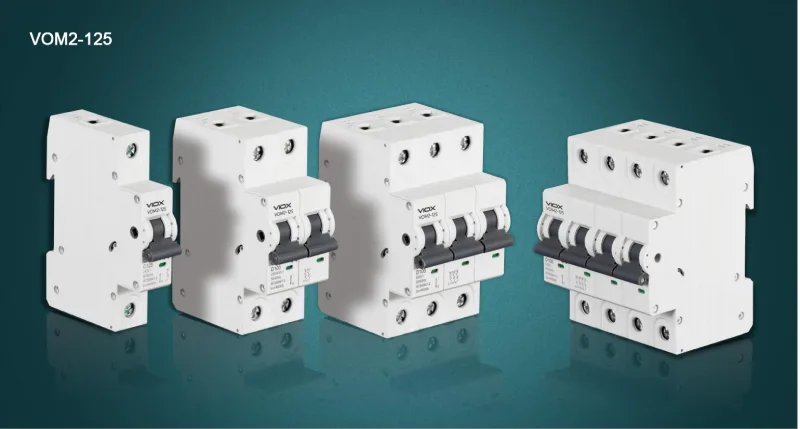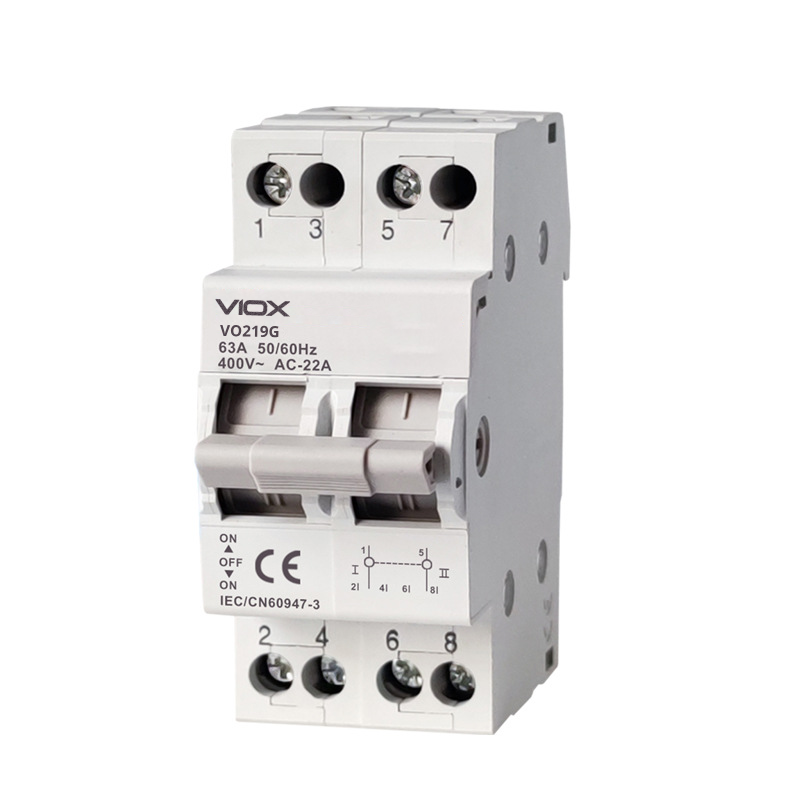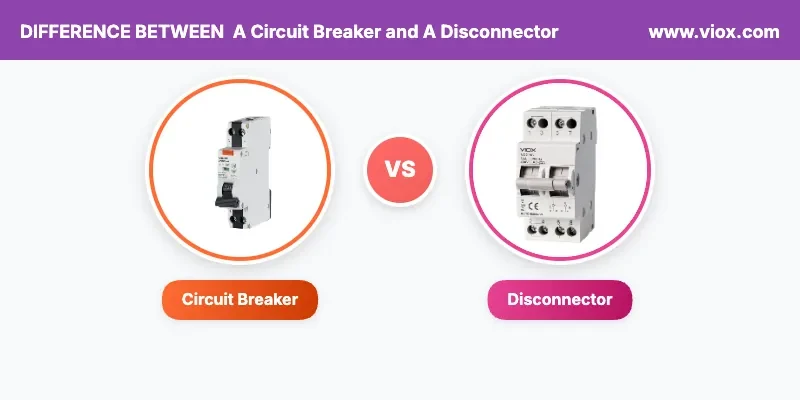Câu Trả Lời Trực Tiếp: A circuit breaker automatically interrupts electrical current during fault conditions and can operate under load, while a disconnector (isolator) provides visible isolation for maintenance purposes and should only operate when circuits are de-energized. Circuit breakers offer protection; disconnectors provide isolation.
Understanding the difference between circuit breakers and disconnectors is critical for electrical safety, proper system design, and code compliance. Both devices control electrical circuits, but they serve fundamentally different purposes in electrical systems.
Key Definitions: Circuit Breakers vs Disconnectors
Cầu dao tự động là gì?

Một ngắt mạch is an automatic electrical switching device designed to protect electrical circuits by interrupting current flow when fault conditions occur. It can make, carry, and break currents under normal and abnormal (fault) conditions.
Đặc điểm chính:
- Automatic operation during faults
- Arc tuyệt chủng khả năng
- Can operate under full load conditions
- Provides overcurrent and short-circuit protection
- Resettable after tripping
What is a Disconnector (Isolator)?

Một disconnector, also called an isolator, is a mechanical switching device that provides isolation of circuits for maintenance and safety purposes. It creates a visible gap between electrical contacts when open.
Đặc điểm chính:
- Manual operation only
- Visible isolation gap
- Operates only when circuits are de-energized
- No fault interruption capability
- Prevents accidental energization during maintenance
Bảng so sánh toàn diện
| Năng | Cầu dao điện | Disconnector (Isolator) |
|---|---|---|
| Mục đích chính | Protection against faults | Isolation for maintenance |
| Hoạt động | Tự động và thủ công | Chỉ hướng dẫn sử dụng |
| Arc Tuyệt Chủng | Yes (SF6, vacuum, oil, air) | No – minimal or none |
| Load Breaking | Yes – full load capability | No – load-free operation only |
| Fault Current | Interrupts fault currents | Không thể ngắt dòng điện sự cố |
| Visible Gap | Không bắt buộc | Required for safety |
| Tiêu chuẩn | IEC 62271-100, IEEE C37 | IEC 62271-102, IEEE C37.30 |
| Typical Voltage | All levels (LV to EHV) | Medium to high voltage |
| Chi phí lắp đặt | Cao hơn | Thấp hơn |
| Bảo trì | Complex mechanism | Simple mechanism |
Critical Differences Explained
1. Fault Interruption Capability
Máy cắt mạch:
- Designed to interrupt fault currents up to their rated capacity
- Use arc extinction media (SF6 gas, vacuum, oil, or air)
- Can break currents many times their normal rating during faults
- Essential for system protection
Disconnectors:
- Cannot interrupt fault currents safely
- May create dangerous arcing if opened under load
- Used only after circuit is de-energized by other means
- Primarily isolation, not interruption
2. Operating Conditions
Máy cắt mạch:
- Operate under normal and fault conditions
- Can make and break full load currents
- Function automatically during abnormal conditions
- Suitable for frequent operation
Disconnectors:
- Operate only under no-load or minimal load conditions
- Require circuit to be de-energized before operation
- Manual operation with visible position indication
- Infrequent operation for maintenance purposes
Dr. Trước An Toàn Cảnh Báo: Never operate a disconnector under load conditions. This can cause dangerous arcing, equipment damage, and severe safety hazards.
Ứng dụng, Sử dụng trường Hợp
When to Use Circuit Breakers
Ứng dụng công nghiệp:
- Bảo vệ và điều khiển động cơ
- Feeder protection in distribution systems
- Generator and transformer protection
- Fault current interruption in power systems
Ứng dụng thương mại:
- Main service disconnect protection
- Bảo vệ mạch nhánh
- Load center applications
- Automatic transfer switch integration
Ứng dụng dân dụng:
- Bảo vệ bảng điện chính
- Bảo vệ mạch riêng lẻ
- GFCI and AFCI protection
- Whole-house surge protection integration
When to Use Disconnectors
Substation Applications:
- Bus sectionalizing
- Equipment isolation for maintenance
- Visible isolation requirements
- Line switching in transmission systems
Ứng dụng công nghiệp:
- Motor disconnect switches
- Cách ly thiết bị
- Maintenance safety isolation
- Emergency disconnection points
Maintenance Applications:
- Creating safe work zones
- Quy trình khóa/gắn thẻ
- Equipment servicing isolation
- Visual confirmation of de-energization
Selection Criteria and Expert Guidelines
Choosing Circuit Breakers
Key Factors to Consider:
- Rated Current: Must exceed normal operating current
- Breaking Capacity: Must exceed maximum fault current
- Voltage Rating: Must match or exceed system voltage
- Type of Load: Motor, resistive, capacitive considerations
- Environmental Conditions: Indoor/outdoor, temperature, contamination
Chuyên Gia Mẹo: Always consult fault current studies when selecting circuit breakers. The breaking capacity must exceed the maximum available fault current at the installation point.
Choosing Disconnectors
Key Factors to Consider:
- Isolation Requirements: Visible gap specifications
- Mechanical Endurance: Expected operating cycles
- Environmental Rating: Weather resistance for outdoor units
- Interlocking Requirements: Safety interlocks with other equipment
- Accessibility: Ease of operation and maintenance access
Chuyên Gia Mẹo: Specify disconnectors with auxiliary contacts for remote indication of position. This enhances safety and operational awareness.
Tuân thủ quy định và an toàn
Điện quốc gia Mã (ĐƯỢC...) yêu Cầu
Điều 240 – Bảo Vệ Quá Dòng:
- Circuit breakers must provide overcurrent protection
- Proper coordination with upstream protective devices
- Arc-fault and ground-fault protection requirements
Điều 430 – Động Cơ:
- Motor branch-circuit short-circuit protection
- Motor disconnect requirements within sight
- Combination motor controllers specifications
IEEE Standards Compliance
IEEE C37 Series Standards:
- C37.04: Standard for circuit breaker rating structure
- C37.06: AC high-voltage circuit breaker standards
- C37.30: Disconnecting switch standards
Các điểm tuân thủ chính:
- Proper application within ratings
- Environmental qualification testing
- Seismic qualification where required
- Electromagnetic compatibility requirements
Dr. Trước Đề Nghị Chuyên Nghiệp: Always consult with licensed electrical engineers for medium and high-voltage applications. Improper selection can result in catastrophic failures.
Những cân nhắc về lắp đặt và bảo trì
Circuit Breaker Installation Best Practices
Step-by-Step Installation Process:
- Lập kế hoạch trước khi cài đặt
- Verify electrical ratings match application
- Confirm available fault current levels
- Kiểm tra điều kiện môi trường
- Physical Installation
- Follow manufacturer torque specifications
- Ensure proper conductor termination
- Verify mechanical clearances
- Thử nghiệm và Đưa
- Primary injection testing for protection relays
- Kiểm tra hoạt động cơ học
- Timing and contact resistance testing
Disconnector Installation Best Practices
Step-by-Step Installation Process:
- Site Preparation
- Verify foundation requirements
- Check clearance to live parts
- Ensure accessibility for operation
- Lắp đặt cơ khí
- Follow manufacturer alignment procedures
- Verify operating mechanism function
- Test interlocking systems
- Kết nối điện
- Use proper conductor termination methods
- Apply specified contact pressure
- Verify auxiliary circuit connections
Sự Cố Vấn Đề Chung
Circuit Breaker Problems
Symptom: Breaker Won’t Close
- Check control power supply
- Verify spring charging mechanism
- Inspect mechanical interlocks
- Test closing coil continuity
Symptom: Nuisance Tripping
- Analyze load current profiles
- Kiểm tra các kết nối lỏng lẻo
- Verify proper time-current coordination
- Xem xét các yếu tố môi trường
Disconnector Problems
Symptom: Difficult Operation
- Inspect operating mechanism lubrication
- Kiểm tra sự ràng buộc cơ học
- Verify proper adjustment
- Examine contact wear
Symptom: Poor Contact Performance
- Check contact pressure settings
- Inspect for contamination
- Verify proper alignment
- Consider contact material compatibility
Nhanh Hướng Dẫn Tham Khảo
Circuit Breaker Quick Facts
- Chức năng chính: Automatic fault protection
- Can Operate: Under load and fault conditions
- Sự tuyệt chủng của hồ quang: Yes – multiple technologies available
- Ứng dụng điển hình: Protection and switching
- Mã tham chiếu: NEC Article 240, IEEE C37 series
Disconnector Quick Facts
- Chức năng chính: Isolation for maintenance
- Can Operate: Only when de-energized
- Sự tuyệt chủng của hồ quang: No – relies on air gap
- Ứng dụng điển hình: Isolation and visible disconnect
- Mã tham chiếu: NEC Article 430.102, IEEE C37.30
Những Câu Hỏi Thường
Can a disconnector replace a circuit breaker?
No, a disconnector cannot replace a circuit breaker. Disconnectors lack fault interruption capability and cannot provide overcurrent protection required by electrical codes.
When should both devices be used together?
Both devices are commonly used together in medium and high-voltage applications where protection (circuit breaker) and isolation (disconnector) functions are both required for safe operation and maintenance.
What happens if you operate a disconnector under load?
Operating a disconnector under load can cause dangerous arcing, equipment damage, fire hazards, and potential injury. This practice violates safety codes and manufacturer recommendations.
Có sẵn thiết bị kết hợp không?
Yes, some manufacturers offer combination circuit breaker-disconnector devices, particularly for motor applications. These devices provide both protection and visible isolation in a single unit.
How do you determine the proper sequence of operation?
For systems with both devices, always operate the circuit breaker first to interrupt current, then operate the disconnector for isolation. Reverse this sequence when re-energizing.
What are the typical maintenance intervals?
Circuit breakers typically require maintenance every 5-10 years depending on application and manufacturer recommendations. Disconnectors may require maintenance every 10-15 years due to their simpler mechanisms.
Can disconnectors be automated?
Yes, disconnectors can be equipped with motor operators for remote control, but they still should only operate under no-load conditions and typically require additional safety interlocks.
What are the different types of circuit breaker technologies?
Main types include air circuit breakers (ACB), vacuum circuit breakers (VCB), SF6 gas circuit breakers, and oil circuit breakers, each suited for different voltage levels and applications.
Đề Nghị Chuyên Nghiệp: For any electrical installation or modification involving circuit breakers or disconnectors, consult with a licensed electrical engineer or certified electrician. Proper application of these devices is critical for safety, code compliance, and reliable operation.
Hãy nhớ: Circuit breakers protect your electrical system from faults, while disconnectors protect you during maintenance. Both are essential components of safe electrical design, but they serve distinctly different purposes and must never be confused or misapplied.


